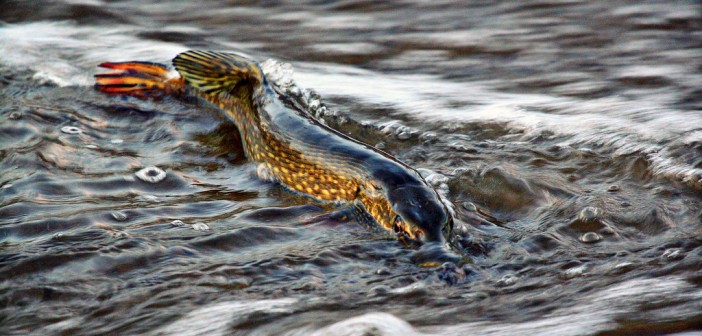(Featured image: spawning pike. Credit Rich Engelbrecht, used under CC BY-NC-ND 2.0)
As individuals we are faced with the dilemma of whether to stay at home or to move and seek our fortune elsewhere. It is common in nature that animals return and reproduce at the place of birth, but the reasons for such homing behavior are often obscure. A study of pike in the Baltic Sea coastal areas of Sweden reveals that if individuals spawn at the same place they were born this gives their offspring a better start in life.
Pike is a large, long-lived, predatory fish species that inhabits lakes and brackish coastal waters. In the Baltic Sea, migratory pike coexists year round but display natal homing behaviour and spawn in the same stream where they were born. Researchers from Linnaeus University in Kalmar, Sweden set out to investigate the causes and consequences of this spawning migration behavior by testing for local adaptation in traits associated with reproduction. The researchers experimentally translocated 2500 pike embryos between the adjacent but separate spawning habitats of two coexisting subpopulations.
Lead author Hanna Berggren reports: “results show that offspring perform better in their native habitat than in a non-native habitat, and they are more successful than translocated immigrants from the other subpopulation. This demonstrates that pike have evolved local adaptations to their spawning environment, despite being separated only for a short time and a by short distance during the reproductive period – which is rare.”
Another key finding was that the effect of translocation on offspring viability varied among families. Hanna Berggren continues: “some families suffered and some were not affected at all, whereas others even benefitted from being moved away from home to a non-native habitat. This is important because variability and plasticity can help populations to better withstand environmental changes.”
The research team also investigated whether female pike invested differently into reproduction, to compensate for differences in survival of eggs and embryos between spawning habitats. Co-author Oscar Nordahl elaborates: “some females invested much into reproduction and produced many small eggs, whereas other females invested less and produced fewer but larger eggs, depending on subpopulation.”
The overall results are intriguing in that they show local adaptation under conditions where population differentiation might not be anticipated. Senior author professor Anders Forsman concludes: “local adaptations that increase performance of embryos in their native spawning environment may promote homing behavior, and this may in turn reinforce reproductive isolation and allow for continued divergence among subpopulations. This type of feedback loop might play an important role in shaping biodiversity – also in other systems.”
That behavioral decisions can impact on population genetic structure even over very small spatial scales is crucial to acknowledge in conservation and management programs, the authors say.
Read the article:
Berggren, H., Nordahl, O., Tibblin, P., Larsson, P. and Forsman, A. 2016. Testing for local adaptation to spawning habitat in sympatric subpopulations of pike by reciprocal translocation of embryos. PLoS ONE 11(5): e0154488.
Link to the article: http://dx.doi.org/10.1371/
More information:
The authors are part of the prominent research centre Linnaeus University Centre for Ecology and Evolution in Microbial model Systems, EEMiS.





